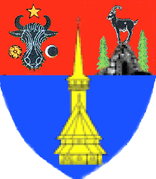Lăpuș
| Lăpuş | |
|---|---|
| Commune | |
 Lăpuş | |
| Coordinates: 47°29′44″N 24°0′25″E / 47.49556°N 24.00694°E | |
| Country |
|
| County | Maramureş County |
| Population (2002)[1] | 3,828 |
| Time zone | EET (UTC+2) |
| • Summer (DST) | EEST (UTC+3) |
Lăpuş (formerly Lăpuşul Românesc; Hungarian: Oláhlápos) is a commune in Maramureş County, Transylvania, Romania, on the Lăpuș River, at 12 km from the town of Târgu Lăpuş. It is composed of a single village, Lăpuş. Etymologically, its name appears to come from the Hungarian lápos (i.e. "flatland, bog, muddy place"). Its existence is attested, under the name of Dragosfálva, in 1293, in an edict through which the land of Lápos is given by the king of Hungary to one Denis Tomaj, from the nation of the Patzinaks,[2] although there are traces of habitation in the area as early as the Bronze Age. It was a famous anti-communist resistance area after World War II (1949-1953).
It has a beautiful old wooden church, built at the end of the 17th century, that was restored between 2002 and 2004.
Notes
- ↑ Romanian census data, 2002; retrieved on March 1, 2010
- ↑ Barons and Other Nobles
Further reading
External links
| Wikimedia Commons has media related to Lăpuş, Maramureş. |
- Older black and white pictures from Lăpuş - Photos by Magne Antonsen
- Panorama of the northern part of Lăpuş
- The old wooden church of Lăpuş
- The largest Bronze Age construction from South-Eastern Europe discovered by archaeologists in Lăpuşul Românesc
Coordinates: 47°29′44″N 24°0′25″E / 47.49556°N 24.00694°E
